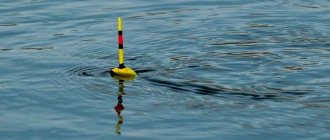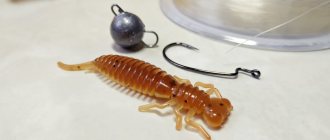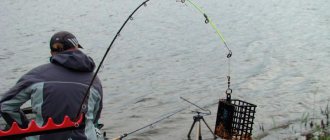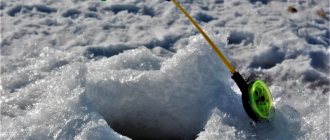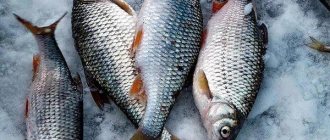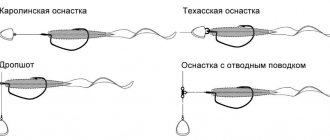Types of sinkers
Types of sinkers
The sinker, along with the float, hook and line, is an important element of equipment not only for a fishing rod, but also for a spinning rod. Let's talk a little about what types of sinkers there are and how they differ from each other.
There are the following types of sinkers:
- Sliding
. A sinker of this type slides freely along the fishing line up to a certain point (knot, stop bead, etc.). Such sinkers are ideal for reservoirs with a hard bottom. The center of gravity of the sinker is shifted towards the base, so when the fish grabs the bait and pulls it up, there is a greater chance that the fish will catch the hook. When, when casting the tackle, the sinker touches the surface of the water, the noise effect is minimal. - Fusiform
. For a long time these sinkers were considered champions in casting distance, until they were replaced by remote sinkers. Nowadays, such sinkers still remain popular due to their streamlined shape, in which the sinker does not catch the algae when pulling the tackle out of the water. In addition, no one has canceled the casting range. - Remote.
As stated above, these are sinkers for the most distant requests. Thanks to their streamlined shape, such sinkers behave much more stable during flight, thereby reducing the likelihood of entanglement, making fishing a pleasure. - Pear-shaped.
This sinker symbolizes, first of all, the accuracy of casting and the self-cutting effect. Hitting the soft muddy bottom (for which the sinker was created), it becomes enveloped in silt and the fish sits tightly on the hook. - Ball-shaped.
If you love the self-cutting effect, then this type of sinker is just for you. Thanks to its simple shape, the sinker “falls” into the bottom of the reservoir and becomes heavier, so hooking is practically not required. A significant disadvantage can be called its “not tenacity”. It will not be able to stay on a flat bottom or slope. Therefore, these sinkers are used much less frequently than others, although in some cases it is not replaceable. - Tenacious.
Sinkers, which, due to unevenness on their surface, cling to the bottom of the reservoir. Sinkers are very effective in reservoirs with large currents or uneven bottoms. Such sinkers are used by professionals for fishing on edges and slopes. - Drobinka
. One of the simplest sinkers is the so-called pellet. If your float has feedback, then you will need another pellet. Typically, a pellet-type fishing sinker is used when fishing in calm bodies of water (ponds, lakes, reservoirs). With a strong current, it is not capable of performing a high-quality dive; it will constantly be carried away and lifted. In this case, the size must be increased, which entails negative consequences. The large size of the sinkers will alert the fish, as the standard bait does not match its resistance when biting. In this case, it is necessary to use sliding sinkers. - End sinker
. Fishermen should also have an end sinker. If anyone doesn’t know, they are used mainly in river areas with collapsed soil. It is behind such blocks that fish like to be. Here the bottom surface is characterized by thickets of silt, the bottom is soft, and above all this there is a current. That’s why sliding sinkers here may simply sink or not allow the line to pass through. As a result, the float does not always respond to a bite; in addition, the silt can drag in the bait, which is why the fish simply will not see it. In this case, the end sinker will come to the rescue, which is a heavy buckshot that is placed below the hook with a leash. For such a sinker, separate leashes are created, which should be no longer than the leash with a hook. Fishing with such a sinker allows you to easily transfer bites to the float.
Flat pear-shaped sinker
I remember when I was a kid my dad used this type of sinker to catch catfish on the river. These flat, pear-shaped weights are ideal for fishing in strong currents because they lie on the bottom to prevent them from rolling off. A bottom rig is a sliding weight that allows you to pass line through it and attach it to a swivel, followed by a leader with a hook and bait, somewhat reminiscent of a Carolina rig. This rig is best suited for fishing in strong currents for catfish or sturgeon on large rivers such as the Volga.
Material
Different manufacturers of fishing sinkers have different material compositions. The basis of most sinkers used today is lead, to which antimony or bismuth is added in small quantities for rigidity. But with the selection of sinkers according to the hardness of the material, anglers have difficulties.
Shot that is too hard damages the line at the clamping point and during movement. A material that is too soft, on the contrary, does not adhere well to the fishing line; the pellet constantly slips, becomes deformed, and wears out. Selecting hardness is not so easy; as stated, there are no standards for the material. Only your own experience of bending and unbending pellets and tracking how the fishing line behaves will help.
Soft pellets include those that can be pinched with your fingers or small tweezers, but not with pliers. After clamping, the weight should move with effort along the fishing line, while the fishing line should not be damaged or twisted. Thus, for very thin lines of float rods, shot made of a very soft material should be used.
Shape and dimensions of sinkers
Sinkers can weigh from several grams to several hundred grams, depending on the nature of the gear and the conditions of its use.
When fishing at sea or in a body of water with a strong current, the same float fishing rod is equipped with a sinker that is significantly heavier in weight. This could be, for example, not only a lead “olive”, but also a lead “pyramid” weighing up to 100g (and sometimes more).
Sinkers of large sizes and masses are widely used not only in fast currents. They are an indispensable attribute of many amateur bottom tackles.
Pyramid
The ancient Egyptians believed in the power of the pyramid, and you can too when you use these inverted pyramid profile sinkers. This sinker works best in fast currents because its streamlined shape causes it to sink quickly, and the flat edges of the weight prevent it from rolling around in strong water flow. When fishing on sandy or muddy bottoms, the sinker sinks into the soft bottom to keep the bait in the same place.
Share link:
Securing weights
Sinkers can be sliding or tightly fixed. Blind fastening is carried out by crimping on a fishing line, or by tying in a certain place. The sinker will injure the fishing line less if you place a cambric under the crimp area or protect the vein by wrapping it with woolen thread. We must always remember that lead is poison. There is no need to use your own teeth as pliers. To crimp such sinkers, you must have small pliers or tongs with you.
Sliding fastening is carried out by putting a sinker on the fishing line. Its movement is limited by stoppers, which allows it to move and slide within specified limits. In some varieties of bottom fishing rods, the sinker is tied to a leash, and the leash moves along the main line on a ring between the stoppers.
Features of using sinkers
Equipping with a sinker
To equip thin fishing lines, you will need whole sets of weights, with pellet weights from 0.05 to 0.5 grams. Such ready-made sets are sold in fishing stores, and each shot number is stored separately.
The marking of the shot must be applied to the compartment in which it is stored, and in grams, since the shot is matched to the known (in grams) buoyancy of the float. If this is not done by the manufacturer, then it is better to write a lot of weights on the boxes yourself with a marker. This allows you to accurately and quickly select a load for a specific float and quickly design equipment, and is very convenient, especially if you don’t have “extra” time while fishing.
Installing 5 or more weights on a fishing line increases the likelihood of tangling the equipment; such a fly fishing rod is difficult to control, which means fishing becomes tense and ineffective. But such a number of weights is not always justified.
Well, why would a carp, which has its snout pressed against the bottom and doesn’t think about looking back, need a slowly sinking and tangled rig? It is much more effective to use one weighty sliding sinker-olive and a small sub-sink, which will act as an anchor at the bottom. (Of course, it happens that carp take it “on the fly” - you need to navigate...)
If the equipment still gets tangled, then preliminary removal of the weights from it helps to untangle the fishing line. This technique saves a lot of time. After unraveling, you can very quickly install the weights in their places.
Many fishermen surround a float rod the old fashioned way. Having obtained lead from somewhere (from an old battery, various devices, from cable braiding), it is splashed into plates 0.2 - 1.0 mm thick, then pieces are cut out from the plates, usually of a larger mass than necessary. These pieces of lead are bent and clamped around the fishing line. Then, near a bucket of water, check the weight of the equipment and bite the lead with wire cutters until the float is loaded as required.
The good thing about such a load is that you got the lead for free. But this technology has several significant disadvantages:
- redoing or replacing equipment is problematic. Loading the float accurately takes a very long time and is inconvenient, especially in camping conditions; this requires a special specialist. tool, and gnawing lead with your teeth is very harmful.
- plate weights do not stick well to the fishing line, so they have to be clamped with force, and the fishing line wrinkles uncontrollably.
- the fishing line clings to the charcoal lead plates and is more likely to get tangled.
- plate weights, even of small mass, create decent resistance in the water when moving and quickly twist the fishing line; they are not applicable in the current.
So, surround it with cut out pieces of lead, which is called more expensive. It is better to use the recommendations given above.
Casting a donkey
When dynamically pulling out the bottom, the sinker - spoon works like a real spinner spoon, and it’s simply a sin not to use it to break through the bottom topography, find promising differences on it and urgently adjust the casting range. Or even change the place of fishing if the subtle fishing intuition requires it.
Tips for fisherman: All about fishing with an English bottom rod - What is the difference, pros and cons
All the bottoms are laid in the target, the surface current draws long “whiskers” from the stretched fishing line, and a simple fisherman’s dinner in the evening twilight becomes only a forced short break in bottom fishing. The ringing of a bell or a suspicious change in the position of the fishing line is immediately regarded as a bite. Then run to the tackle, pick up a little slack, hook! And here it is, that joyful fishing feeling when at the other end of the fishing line something large moves in wide circles, giving us an unforgettable experience!
Fishing conditions can be very different, but I will focus on the most typical ones. First of all, let me clarify that by fishing conditions I mean the combination of all factors: the presence and speed of currents, depth, surface and bottom currents, wind, water waves, distance, bottom topography at the fishing point and fish activity.
Equipping your fishing rod correctly means half winning the battle. Fish can be caught with random equipment. But not much at all. And also random. If you want to fish consistently with professional quality, pay attention first of all to your equipment. Further - based on materials from A. Yanshevsky, a famous sports fisherman and the author of numerous publications on fishing topics.
Fishing Habit
The fact is that many fishing enthusiasts often fish in the same body of water, and, as they say, grind their gear to it. The fisherman constantly uses the same floats with hooks and uses the same fishing techniques.
Once on an unfamiliar body of water, a fisherman is not looking for accumulations of fish, but for places where he can use his gear and established fishing techniques. As a result, on a new body of water, the fisherman increases his collection of places convenient for fishing, without improving his skills and without mastering new gear and methods.
A new place has its own equipment
For example, athletes are required to fish in the sector that was drawn by lot, so they are to some extent spared from such a vicious circle. Although at present this is not entirely true. Often competitions are held in convenient similar places that have a lot in common, and athletes, as well as amateurs, are limited to a not too wide range of equipment, which they bring to perfection.
For many anglers, achieving the harmony of fishing in a familiar place with good tackle is a pleasure. But still, at some point you want something new and unexplored.
Often, trying to fish in completely unfamiliar conditions is driven by information from other fishermen, the desire to expand your capabilities and trophies. And then the moment comes when you come to a new place and the proven equipment and floats become ineffective.
Choosing fishing rod equipment
For novice fishermen, it is even more difficult to navigate a new place. They have no established habits. But these habits can do a disservice even for experienced ones. What can help most in an unfamiliar situation is information from local fishermen, i.e. already have experience of fishing in this body of water.
But it’s even better to be guided by your own thoughts and take into account generalized information about this or that equipment in certain conditions. Such generalizations are possible and every fisherman has them, but they are rarely talked about.
Recently, the range of floats has expanded significantly, but the problem of choosing a float and equipment remains.
The difficulty of choosing lies in the fact that the operation of the equipment depends not only on the design as such, but also on what fishing technique the angler uses.
Often the angler's style determines the design of the equipment, and not the fishing conditions. Therefore, with the same equipment, changing only the distribution of the load in it, you can fish both in currents with shallow depths and in deep standing water.
The most stable floats are also the most versatile, since they allow a wide variety of manipulations with the equipment. But very often, especially during cautious and inactive biting, a special (for specific conditions) design and technique for using it can be decisive. I want to share my own experience in this area.
Options for fishing conditions
Fishing conditions can be very different, but I will focus on the most typical ones. First of all, let me clarify that by fishing conditions I mean the combination of all factors: the presence and speed of currents, depth, surface and bottom currents, wind, water waves, distance, bottom topography at the fishing point and fish activity.
Strong currents combined with great depth create great difficulties for anglers. An example is the channel named after. Moscow, but this is such a particular and repeatedly discussed case that it makes no sense to return to it.
Consider the following example. A river with a smooth, medium or even fast current, with a depth of 4-5 m, at a distance of 10-12 m from the shore. When using a fly rod, the design of the equipment is as simple as possible, since the load is distributed at two points. The underhang is not far from the hook, the main sinker is not far from the underhang. When the rig floats freely, the weight distribution of the sinkers is such that it is possible to notice a possible bite “on the rise”.
The antenna should be matched to the weight of the bait, and the shape of the float is not so important. That is, for bloodworms and maggots, floats with a thin antenna are used, and for worms and heavy grains of corn or wheat, it makes sense to take floats with a thicker antenna.
In the case when you hold the rig floating, the current will lift the bait. The speed and height of the rise depend on the strength of the current, the mass of the bait, the artificial reduction in the speed of swimming, the distribution of sinkers and the resistance of the leash, that is, on its length and the diameter of the fishing line. Sometimes fish like it when the bait rises abruptly and quite high, and sometimes it’s the other way around.
A long leash is often used not only to make the bait play more actively, but also to delay the transmission of the bite to the bait. Large fish throw the bait if they feel the slightest additional resistance, and to prevent this from happening, the length of the leash is increased to 1 m or even more.
As soon as the fisherman begins to manipulate the equipment, he is faced with the question of choosing a suitable float. The more actively you manipulate the equipment, the more important the shape is.
For example, with periodic twitching of the equipment, alternating with a long free swim, designs (see photo above) 1 and 2 are good. If the current is medium in strength and you have to periodically stop the swim for a short time, then it is better to choose floats 3 and 4.
If, after casting, you fix the rod in one position and do not accompany your equipment with the rod, then it will float in an arc towards the shore. In this case, it is better to take a stable structure 5. The thin upper part of the body of which will show a bite even without an antenna.
If there are no bites on the rise (which depends on the fishing technique, and not on the fact that the fish lifts the bait and bait), then equipment with a float 6 is good. All of the above applies to fishing in a not very strong current and at a fairly large depth, when using equipment weighing approximately 6 g.
As the depth decreases, the requirements for choosing a float become more stringent. The fact is that the smaller the descent, the lighter the equipment required, but the main thing is that the distance between the float and the load is reduced and the entire structure as a whole becomes less stable.
Tips for fisherman: How to make bottom tackle for crucian carp - What to choose for fishing
That is, it reacts to more minor forces, be it the turbulence of water or the pulling of equipment by a fisherman. At shallow depths it is necessary to use the most stable structures.
Floats with a low center of gravity are easiest to control. It is convenient if the float takes a vertical position in the water even before the weight has dropped. The distribution of the sinkers only becomes more complex when their total mass is approximately 1.5 g or more. Complex weight distribution is used when the angler is actively manipulating the rig.
If you use free floating, then all floats work with almost any distribution of weights, as long as the float quickly takes its working position. It is worth noting that in a ragged, turbulent flow with eddies, floats with an extended upper body (7 and 8) perform better. Free swimming at shallow depths is effective if the water is not cloudy and the fish are active.
In summer, when there is a lot of natural food and it is distributed by water flows over all horizons, you have to play with bait. To achieve this, the lightest but controllable equipment with the most stable floats is designed.
Floats 9 and 10 are good for this purpose. The latter are especially effective in holding the equipment at the fishing point, provided that the bait on a long leash goes much higher than the bottom. Almost the entire antenna of the float comes out of the water, but the bites are very visible.
In the final choice of a float, the manner of playing with the equipment, which is individual for each angler, plays a big role.
Loading the float
The simplest loading scheme is a sub-weight and a main sinker (Fig. 1). This design works well in currents.
If the fish takes much higher than the bottom and the bites are cautious, it makes sense to move the main sinker and distribute the sinkers along the line (Fig. 2).
With the selection of equipment for fishing in still water, the situation is somewhat more complicated, but more on that next time.
- rodents;
- representatives of the animal world of small size;
- bird (waterfowl);
- fish that are large in size are a fairly successful type of bait;
Sinker storage
Storing sinkers
You only need a small amount of sinkers. First of all, you need a pair of sliding “olive” sinkers. Secondly, it is good to have with you a set of lead weights of each size weighing from 0.5 to 1.5 grams. They are convenient for creating simple equipment, as well as for catching carp and crucian carp at shallow depths. Such cargoes are often the main ones and make up more than half of the total weight of the shipment. For carp fishing, a good rig with one “olive” and a small pad, which can be moved to the locking knot in shallow water.
For precise loading, small pellets are used. Before creating a stockpile, you need to determine what and how many pellets you need.
It is best to store sinkers separately in special cases indicating the markings and weight, then creating new equipment will be much easier. Sliding weights are best stored with pieces of fishing line or wire stretched through them. This will prevent the channels from closing when the weights hit each other during transportation.
“Olives” and pellets are used not only in float equipment. Depending on the situation during fishing, you can change the load of the equipment, and installing or removing the sinker from the fishing line is an instant matter. Tungsten “olive” sinkers have also proven themselves well in bottom and spinning rigs.
Ribalka-info
In addition to the fixed mounting on classic jig heads and the swivel connection of baits with eared weight heads, other types of equipment are also widespread in jig fishing. I will tell you about my version of equipment for fishing in deep snags.
Equipment for snags and rocky bottom. My long-time friend in spinning fishing on the Oka River, Dmitry Karpov from Serpukhov, knows the catch points very well and knows how to fish in local conditions.
In 2003, I saw in his arsenal the simplest version of equipment, which will be discussed. It was a piece of steel wire with a sliding voluminous olive weight and rough twists at the ends, to one of which a bait was attached to an offset hook. Dmitry used this equipment in places with strong currents and rocky bottoms, where the consumption of baits on rigs with conventional weight heads was too high. Testing this equipment, I was convinced of its high efficiency. However, I was not satisfied with the shape of the load and the quality of the twists: by that time I had already been making leashes for spinning fishing from steel wire of a completely different quality for several years. Having decided to modify the equipment, I began by selecting the optimal shape of the load. The voluminous olive used by Dmitry had very good flight characteristics, but it did not always pass through snags and between stones. Having gone through all the types of sliding sinkers available to me at that time, I settled on the narrowest olive. It was one and a half times smaller in diameter and twice as long as the original version. Thanks to this shape of the sinker, the equipment began to better pass through strong snags and rubble of stones at the bottom. Since the longitudinal sectional area of a long olive is larger than that of a compact one, the bait with it sank to the bottom noticeably more slowly. At the same time, the range of the equipment has practically not decreased. Fishing with a new version of equipment confirmed its high efficiency in snags. At the same time, some weaknesses of the materials I used came to light. Thus, the twist of steel wire located inside the sliding sinker rusted very quickly, and the sinker itself, made of soft lead, very quickly broke against underwater obstacles. These minor flaws could have gone completely unnoticed if the equipment had lived as short as a regular steel leader, but it was difficult to tear it off even on purpose. To eliminate these shortcomings, I started looking for other components. First, I managed to find a suitable load: it was a sliding “bomb” sinker from . The sinker is made of a hard lead alloy, which prevents damage from snags, shell rock or remains of reinforced concrete structures on the bottom. Another useful quality of a solid lead alloy sinker has been revealed: during a bite, it does not get stuck in the predator’s mouth, which allows for effective hooking with an offset hook. Now “Jiga” produces “bombs” weighing from 3.5 to 21 g in increments of 3.5 g and from 28 to 56 g in increments of 14 g. Then the wire in the equipment was replaced. For several years I could not find the right one until I came across a very interesting material - Stainless Steel Leader Wire from American Fishing Wire (AFW). I came across it quite by accident while searching for leader material for microjigs and microwobblers. Having sampled several diameters of this wire, I quickly became convinced of its high performance qualities when used for leashes for small baits, and later for any baits in general. This leader material is a stainless steel wire with a brown camouflage coating, which, thanks to the hardening, is not prone to excessive twisting. AFW currently offers wire diameters from 0.27 to 0.78 mm with a narrow breaking load of 12 to 109 kg, respectively. Each package of wire contains a coil weighing 114 g, and its length naturally depends on the diameter. I make leaders, non-snagging rigs, lure inserts and other items from AFW wire. After all the improvements, I began to purposefully offer the equipment to my friends for testing in order to cover the possible conditions of use as widely as possible. I also needed to understand whether they would notice one feature in the operation of the equipment, which seemed to me very unpleasant. The fact is that during a sharp power cast or near-bottom wiring with a sweeping swing of the rod tip, the “bomb” moving freely along the wire periodically got stuck at the top twist, which spoiled the entire wiring. When she slid down to the bait with a clear ringing blow, each time I could not resist a convulsive hook. After quite intensive testing on the Rybinsk Reservoir, my friend Yuri Tolpinets and his travel companions highly appreciated the performance of the equipment in those Rybinsk snags that they could not fish before because they used classic weight heads with an offset hook. Yuri also tested the equipment on the canal more than once. Moscow and was convinced that even on a very rocky bottom it significantly reduces the number of cliffs and allows him to fish where he usually would not even try. However, none of those who tested the equipment noted a feature of its operation that alarmed me - the occasional jamming of the load in the upper position. True, after I brought this to their attention, they agreed that there really was such a drawback. It was possible to fix it by installing stoppers made of black dense rubber on the wire, usually used in float fishing and having a fairly high wear resistance. Despite the high resistance of the stoppers, two to four of them are required so that even with a force cast the “bomb” remains in the lower part of the equipment. It is this finalized version of non-meshing equipment that I consider it possible to offer to readers so that they try it and in practice become convinced of the effectiveness of both the equipment itself as a whole and the changes made to its original design. Based on materials from the newspaper “Fisherman of the Fisherman”
Method of making sinkers
Well-molten lead is poured into an aluminum tablespoon slightly sunk into the sand.
After cooling, the cast sinker is freely removed from the spoon. The casting is smooth, with rounded edges and does not require further processing. To attach it to the line, a hole is drilled in the narrowed part of the sinker with a drill or a hole is punched with a nail. Depending on the degree of filling of the spoon, the weight of the sinker ranges from 70 to 200 g. Lighter sinkers - from 20 to 50 g - can be cast in an aluminum teaspoon.
